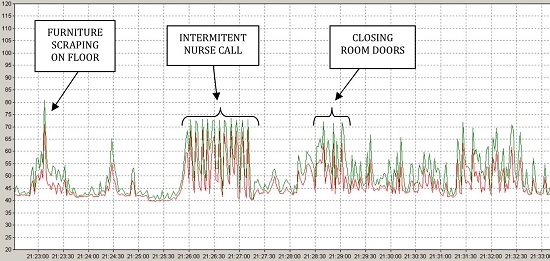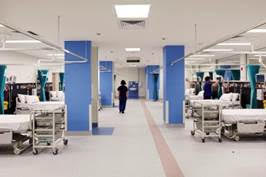Sleep deprivation affects the immune system, the ability to generate new cells, and our tolerance to pain. This, inevitably, lengthens hospital stays, increasing the cost to the NHS
Hospitals, by nature, are busy and noisy places, yet in order to assist in the healing process, patients need a restful space where they can sleep peacefully and recuperate in an environment which also respects their privacy and dignity.
Sleep deprivation affects the immune system, the ability to generate new cells, and our tolerance to pain. This, inevitably, lengthens hospital stays, increasing the cost to the NHS.
The quest for a good night’s sleep
As acousticians, we aim for low internal ambient noise levels to minimise disturbance to patients, particularly during the night.
Health Technical Memorandum (HTM) 08-01 Acoustics - the current UK guidance document for NHS hospitals - recommends an internal level of 35 dB LAeq and maximum level of 45 dB LAmax,f within bedroom wards during the night from noise intrusion, and a noise rating level of NR30 for the building services. These are achieved through the design of the external building fabric and the building services systems.
This target criteria for internal ambient noise levels is suitable for current practices, but the business of caring for patients can’t be done quietly and levels generally exceed the design criteria by 10-15 dB.
This graph from a study of hospital noise undertaken by a previous member of our acoustics team presents the hourly average noise levels across 24 hours within four bedroom wards.
The graph provides interesting information on the consistency of noise level and the variation between day and night. However, it doesn’t illustrate the fluctuation of noise in the short term.

This second graph shows levels captured over a seven-minute night-time period in one of the wards, and it shows over 15 peak noise events which exceed 70 dB.
This is the equivalent of standing 10m from a car driving past at 65mph.
The peak events in this case are caused by furniture scraping on the floor, nurse calls and doors closing, and they can also be caused by medical equipment alarms, nursing pagers and people talking.
It’s the contrast between the low ambient noise level and these high noise level events that disturbs sleep, as well as affecting staff concentration and stress levels.
Sound masking – the route to sweet dreams
Sound masking is a method of artificially raising the ambient noise level within a space using a series of loudspeakers.
It has been established that raising the internal ambient noise levels reduces the difference between the high level noise events and the underlying ambient noise level, and research indicates this results in less disturbance.
Studies have shown that sound masking, a popular design solution in the US, is extremely effective at reducing sleep disruptions and, therefore, promoting essential sleep patterns.
It has a positive effect on people’s recovery and their overall satisfaction with their environment.
The loudspeakers used to deliver sound masking are small, easy to install and can be mounted in any ceiling type or completely hidden within the ceiling plenum.
It’s the contrast between the low ambient noise level and these high noise level events that disturbs sleep, as well as affecting staff concentration and stress levels
They emit a sound similar to gentle airflow, which has the effect of hiding, or masking, the disturbance of peak sound events. There are also biophilic systems which produce natural sounds such as running water which have similar benefits.
US sleep expert Michael Stanchina undertook a study of volunteers to compare the quality of their sleep first during a baseline night when they were not exposed to any noise, then when they were exposed to recorded noise from an intensive care unit (ICU), and, finally, when they were exposed to the recorded ICU noise combined with sound masking.
The results indicate that when masking was combined with the ICU noise, the sleep disturbance was very similar to baseline night.
A better all-round patient experience
Sound masking also provides the benefit of speech privacy, which is very important in a healthcare setting.
People feel more confident to discuss private matters with medical staff if they know they conversations are confidential.
If the ward is too quiet and they can overhear other people’s conversations, then they know theirs can also be heard.
Sound masking makes conversations by others nearby more difficult to hear and comprehend, which allows patients to feel more confident that their privacy is maintained, which supports more-open conversations, and can help to reduce medical errors.
The efficacy of sound masking as a design solution that puts the health and wellbeing of the occupant at the heart of design, providing increased comfort, health and happiness, is borne out by a survey undertaken at Saint Thomas Hospital in Nashville, USA, where a dramatic 33% increase in patient satisfaction regarding noise levels in and around the hospital was recorded after they installed a sound masking system.

Good acoustics can aid sleep among patients and improve the working environment for staff. Image courtesy of Roger D’Souza Photography
Commercial benefits
Sound masking also has clear commercial benefits through reduced construction costs.
By raising the internal ambient noise level in individual bedrooms or consultation rooms, we can reduce the partition sound insulation performance and achieve the same level of speech privacy between adjacent spaces.
A reduction in the partition performance can lead to changing the wall linings from high-performing SoundBloc to typical Wallboard, or building the partition up to the underside of the suspended ceiling enabling a clear soffit for building services, both of which can lead significant construction savings.
Sound masking makes conversations by others nearby more difficult to hear and comprehend, which allows patients to feel more confident that their privacy is maintained, which supports more open conversations, and can help to reduce medical errors
Since sound masking reduces the disturbance from noise in corridors, the sound insulation of doors can also be reduced.
Changing from an acoustic to a normal doorset reduces cost and, if the door seals can also be removed, has positive knock-on effects for cleaning and infection control in hospital environments.
Finally, there is also the option of adjusting or designing the building services systems to act as sound masking systems in their own right to raise the internal ambient noise levels in hospital wards and consultation rooms. This saves the cost of installing a proprietary sound masking system.
Call for action
This solution presents clear patient and commercial benefits, but in the UK, acoustic conditions in hospitals in the UK are designed in accordance with HTM 08 01, which gives very little scope to use the concept. I believe that we should challenge this stance, and that sound masking should be promoted as a viable design solution to be used in our UK healthcare facilities.




